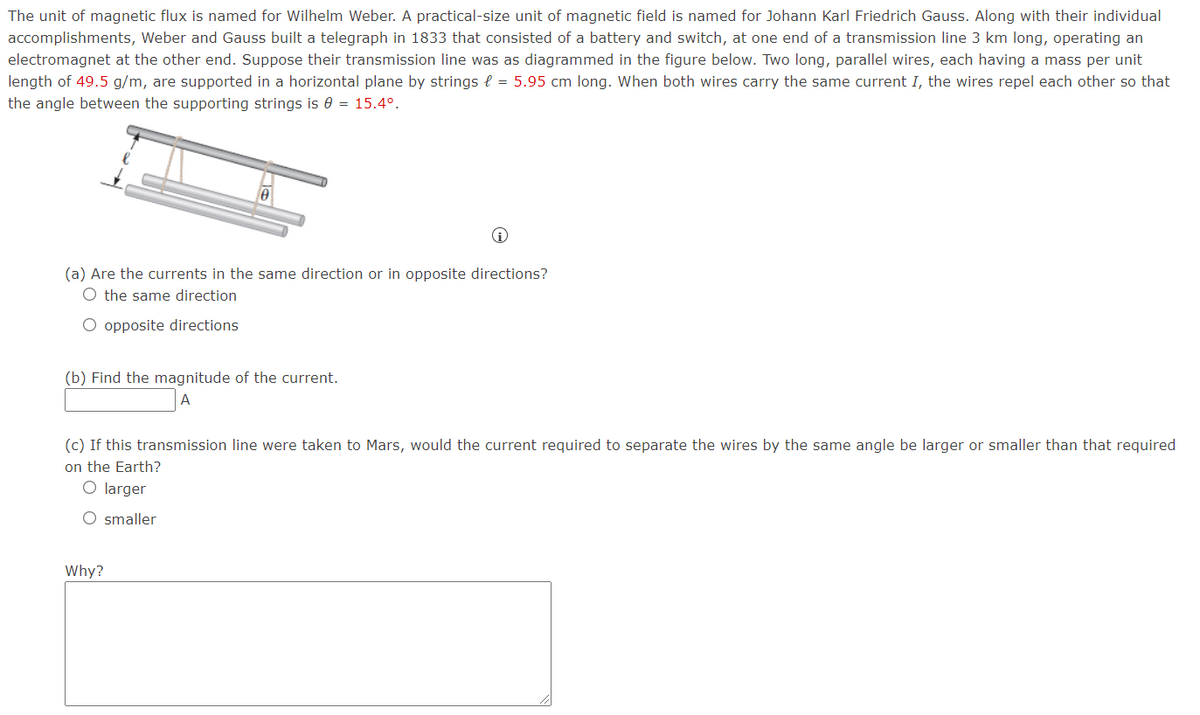The unit of magnetic flux is named for Wilhelm Weber. A practical-size unit of magnetic field is named for Johann Karl Friedrich Gauss. Along with their individual accomplishments, Weber and Gauss built a telegraph in 1833 that consisted of a battery and switch, at one end of a transmission line 3 km long, operating an electromagnet at the other end. Suppose their transmission line was as diagrammed in the figure below. Two long, parallel wires, each having a mass per unit length of 49.5 g/m, are supported in a horizontal plane by strings l = 5.95 cm long. When both wires carry the same current I, the wires repel each other so that the angle between the supporting strings is 0 = 15.4°. (a) Are the currents in the same direction or in opposite directions? O the same direction O opposite directions (b) Find the magnitude of the current. A (c) If this transmission line were taken to Mars, would the current required to separate the wires by the same angle be larger or smaller than that required Earth? O larger O smaller Why?
The unit of magnetic flux is named for Wilhelm Weber. A practical-size unit of magnetic field is named for Johann Karl Friedrich Gauss. Along with their individual accomplishments, Weber and Gauss built a telegraph in 1833 that consisted of a battery and switch, at one end of a transmission line 3 km long, operating an electromagnet at the other end. Suppose their transmission line was as diagrammed in the figure below. Two long, parallel wires, each having a mass per unit length of 49.5 g/m, are supported in a horizontal plane by strings l = 5.95 cm long. When both wires carry the same current I, the wires repel each other so that the angle between the supporting strings is 0 = 15.4°. (a) Are the currents in the same direction or in opposite directions? O the same direction O opposite directions (b) Find the magnitude of the current. A (c) If this transmission line were taken to Mars, would the current required to separate the wires by the same angle be larger or smaller than that required Earth? O larger O smaller Why?
Physics for Scientists and Engineers with Modern Physics
10th Edition
ISBN:9781337553292
Author:Raymond A. Serway, John W. Jewett
Publisher:Raymond A. Serway, John W. Jewett
Chapter29: Sources Of The Magnetic Field
Section: Chapter Questions
Problem 17P
Related questions
Question

Transcribed Image Text:The unit of magnetic flux is named for Wilhelm Weber. A practical-size unit of magnetic field is named for Johann Karl Friedrich Gauss. Along with their individual
accomplishments, Weber and Gauss built a telegraph in 1833 that consisted of a battery and switch, at one end of a transmission line 3 km long, operating an
electromagnet at the other end. Suppose their transmission line was as diagrammed in the figure below. Two long, parallel wires, each having a mass per unit
length of 49.5 g/m, are supported in a horizontal plane by strings e = 5.95 cm long. When both wires carry the same current I, the wires repel each other so that
the angle between the supporting strings is 0 = 15.4°.
(a) Are the currents in the same direction or in opposite directions?
O the same direction
O opposite directions
(b) Find the magnitude of the current.
A
(c) If this transmission line were taken to Mars, would the current required to separate the wires by the same angle be larger or smaller than that required
on the Earth?
O larger
O smaller
Why?
Expert Solution
This question has been solved!
Explore an expertly crafted, step-by-step solution for a thorough understanding of key concepts.
This is a popular solution!
Trending now
This is a popular solution!
Step by step
Solved in 7 steps with 2 images

Knowledge Booster
Learn more about
Need a deep-dive on the concept behind this application? Look no further. Learn more about this topic, physics and related others by exploring similar questions and additional content below.Recommended textbooks for you

Physics for Scientists and Engineers with Modern …
Physics
ISBN:
9781337553292
Author:
Raymond A. Serway, John W. Jewett
Publisher:
Cengage Learning

Physics for Scientists and Engineers
Physics
ISBN:
9781337553278
Author:
Raymond A. Serway, John W. Jewett
Publisher:
Cengage Learning

Glencoe Physics: Principles and Problems, Student…
Physics
ISBN:
9780078807213
Author:
Paul W. Zitzewitz
Publisher:
Glencoe/McGraw-Hill

Physics for Scientists and Engineers with Modern …
Physics
ISBN:
9781337553292
Author:
Raymond A. Serway, John W. Jewett
Publisher:
Cengage Learning

Physics for Scientists and Engineers
Physics
ISBN:
9781337553278
Author:
Raymond A. Serway, John W. Jewett
Publisher:
Cengage Learning

Glencoe Physics: Principles and Problems, Student…
Physics
ISBN:
9780078807213
Author:
Paul W. Zitzewitz
Publisher:
Glencoe/McGraw-Hill


Principles of Physics: A Calculus-Based Text
Physics
ISBN:
9781133104261
Author:
Raymond A. Serway, John W. Jewett
Publisher:
Cengage Learning

Physics for Scientists and Engineers: Foundations…
Physics
ISBN:
9781133939146
Author:
Katz, Debora M.
Publisher:
Cengage Learning